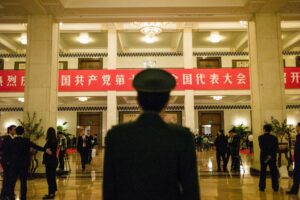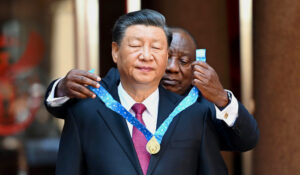When President Xi Jinping first announced his plan to revive the ancient “silk road” between Europe and China in a speech in Kazakhstan 10 years ago, Western leaders paid little notice. There was no indication that the man on stage reciting Kazakh poetry was planning to build an unprecedented global economic network in which all roads ultimately led to Beijing. The Belt and Road Initiative, as it was later christened, would become a symbol of China’s cosmic ambition.
In the decade since, more than a trillion dollars of investment have poured into BRI projects, a figure that rivals what Western countries together put into their aid budgets. That China found eager suitors around the world for its new largesse is no surprise, not least because Western countries had started pulling in their horns — with Britain, for instance, recently cutting an aid budget that had been a pillar of its soft power in order to build an aircraft carrier.
But in filling that vacuum, China has unsettled Western nations and few of them will attend when representatives from more than 100 countries gather in Beijing for the third Belt and Road Forum for International Cooperation. Increasingly, especially in the American foreign policy community, we hear talk that China is using the BRI to build a rival bloc to the West.
In an apparent response to the BRI, at the recent G20 Summit, the US and some of its partners announced an infrastructure programme to connect Asia and Europe. But if they’re hoping to go head-to-head with China, they may want to reconsider their tactics because one thing China is really good at is building infrastructure. In the time we’ve spent trying to make up our minds about whether to dig a short tunnel to Euston station, China has installed nearly 40,000 kilometres of high-speed railway.
In any event, finding nefarious intent in the BRI may say more about the observers than the observed. A recurrent temptation we in the West face is to look at China’s behaviour through Cold War lenses, substituting the Middle Kingdom in the role vacated by the fallen Soviet Union. Seen this way, the BRI appears to be China’s attempt to transform its economic power into political control by drawing a string of countries more closely into its orbit. Some even detect an ideological blueprint in China’s willingness to forge partnerships with autocratic regimes, citing it as evidence that it wants to build an anti-democratic, anti-Western bloc.
In reality, though, there wasn’t much geopolitical thinking behind the original conception of the BRI. Instead, it was concocted by bureaucrats who were trying to solve an economic challenge: China’s economy had run into a wall. To overcome the 2008 global financial crisis, it had embarked on a massive fiscal stimulus and succeeded in lifting the world economy out of recession, but also left itself with a lot of excess capacity. Meanwhile, China was nearing the limits of a growth model that had relied on low-wage workers to assemble goods for export. As the huge surplus labour force was mopped up, wages rose, auguring a future in which Chinese firms would no longer be able to undercut their competitors abroad.
If it were to escape this classic middle-income trap, China would need to orient its output towards more technologically advanced production, and move its labour-intensive assembly offshore. Having built its economy by luring the waves of outsourcing that had helped deindustrialise America, it now needed to do the same and move some of its own manufacturing to lower-wage zones beyond its borders.
A group of civil servants came up with a plan to achieve this: by creating transportation networks that would give it access to overseas markets, supplies, and labour, and then exploiting those links to develop its partnerships, China would be able to expand its economy beyond its national borders. It would not use a classic aid programme like the Marshall Plan to do this, though. Instead, Beijing would encourage its banks to stump up the capital on commercial terms, something they were quite able and willing to do given the vast pools of capital accumulated in a country that saves nearly half its output, and where the list of high-yielding opportunities at home has been diminishing.
The policy proposal landed at a propitious time. With Xi Jinping having just gained power, Beijing was growing increasingly concerned that its good relations with Western trading partners would come under increasing strain. Barack Obama’s ascent to the US presidency and his administration’s pivot to Asia, which boosted America’s military presence as a counterweight to China, solidified this perception. China’s subsequent exclusion from negotiations around the proposed Trans-Pacific Partnership only reinforced that belief in Beijing. Xi made the BRI his own, and it soon became a linchpin of his new economic policy.
While the BRI was crafted as an economic programme, it soon became apparent to the Communist leadership that it could drive a new geopolitical strategy too. For one thing, the BRI gave China the chance to showcase a whole new model of development. Whereas the Western approach to global development focused on using multilateral financial institutions, such as the IMF, World Bank, and World Trade Organization, to engineer pro-market policy regimes, then assist their implementation with targeted aid, China believed that building infrastructure was the key to development. Meanwhile, China regarded the regime of development or governance or human rights a country might choose to use as entirely its own business, a position which reflected its tradition of non-interference. Given the widespread perception in the developing world of Western countries as arrogant imperialists imposing their own moral or economic agendas, China’s standoffishness proved a refreshing change.
All the same, the BRI hasn’t created an alternative global financial architecture — at least not yet. Unlike the multilateral order created at Bretton Woods in 1944, it has more limited ambitions. The IMF, World Bank and WTO operate all over the planet; China’s BRI is focused primarily on Asia, Europe, Africa and Oceania — in effect, in those parts of the world that could at a stretch be called its hinterland. And when it comes to diplomatic engagement, China still prefers to avoid multilateral regimes to focus on the more modest but practical approach of bilateral relations.
This approach, though, is causing China some growing pains as it engages with the world in a way it’s never seriously done before. On the one hand, the BRI is serving the country’s goal of expanding its export potential. But in many countries, especially in Africa where China has a large and growing presence, the administrative capacity to manage complex infrastructure programmes is lacking. As a result, the initial euphoria over Chinese largesse has in recent years given way to a more sober assessment, as payments have come due and some governments have struggled to meet them.
This has led some Western commentators to latch onto the concept of “debt-trap diplomacy”, the idea that China has loaned money with the aim of later swooping in and seizing assets when the debtor defaults on payments. Often cited as an example of this is the case of Sri Lanka, which allowed China to take direct control of one of its ports on a 99-year lease when its government found it couldn’t pay its debts.
But the reality is probably more prosaic. China is learning the hard way what Western governments have dealt with for decades — the problems of insolvency in sovereign debtors. In response, it appears to be re-orienting towards a somewhat more Western style of “small but beautiful” lending that prioritises smaller, targeted projects. Over the years, Western governments have developed an elaborate global architecture through such institutions as the Paris Club, which facilitates the quick resolution of fiscal crises. But China has resisted joining such bodies, instead working through problems on an ad hoc basis. That hasn’t always been easy. Debt diplomacy seldom is, and China is finding that the role of benefactor can ultimately carry a hidden price.
The hype of the BRI’s early years has given way to a more sober assessment of the costs and benefits of engagement with China, as its partner countries find the role of an aspiring hegemon goes beyond just doling out goodies. Many countries still find it useful to have a rival pole they can play off against the US-led alliance, but Italy’s recent reconsideration of its participation in the BRI can probably be seen less as an instance of the Western allies circling the wagons, than of many countries rethinking the degree of dependence on China they’re willing to countenance. China has built its soft power and cut its teeth on diplomacy, but it too is finding that the fun part of the BRI may now be over.
Disclaimer
Some of the posts we share are controversial and we do not necessarily agree with them in the whole extend. Sometimes we agree with the content or part of it but we do not agree with the narration or language. Nevertheless we find them somehow interesting, valuable and/or informative or we share them, because we strongly believe in freedom of speech, free press and journalism. We strongly encourage you to have a critical approach to all the content, do your own research and analysis to build your own opinion.
We would be glad to have your feedback.
Source: UnHerd Read the original article here: https://unherd.com/




